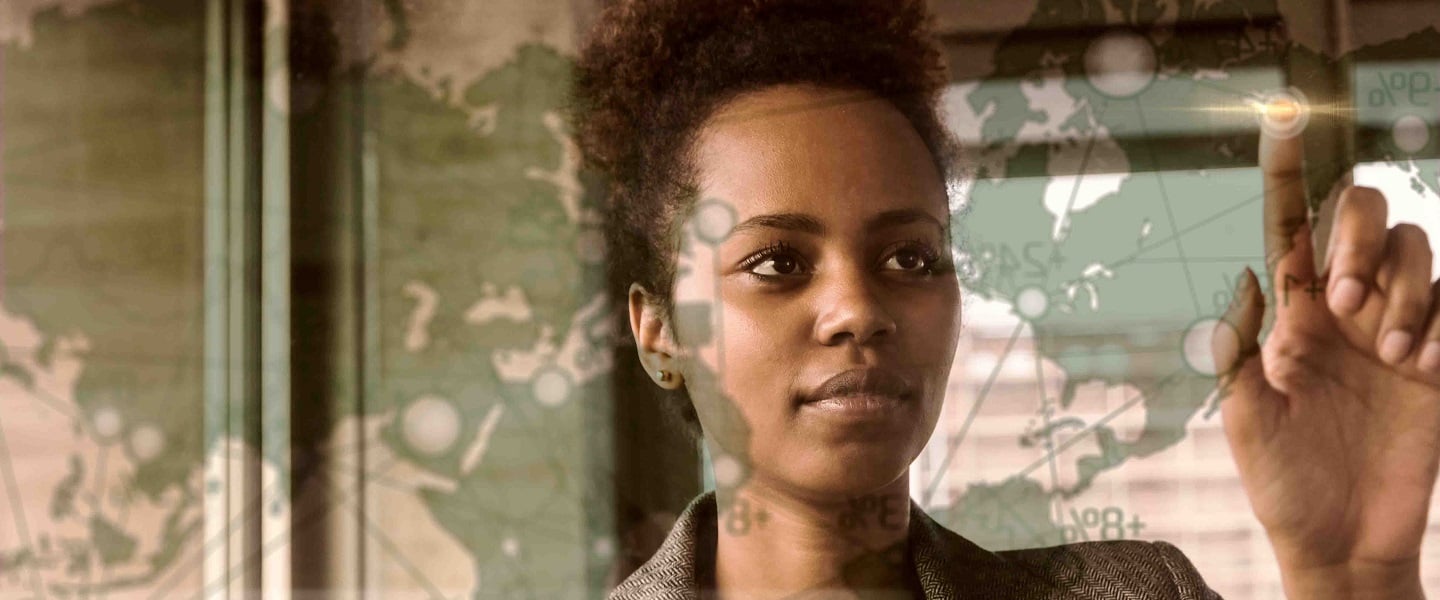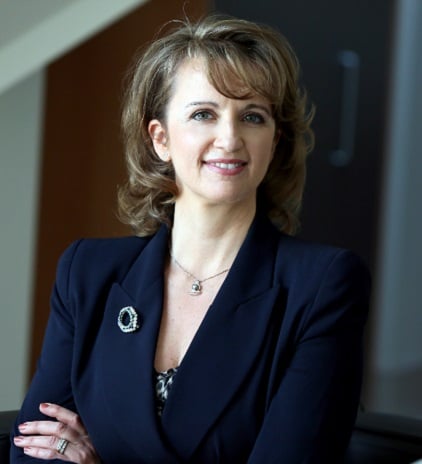
The coronavirus pandemic has redrawn the business map, engendering working practices incorporating remote and flexible working to a previously unanticipated degree. The pandemic altered customer demands and increased competition, changing not just how companies operate, but who and where they hire. Oxford Economics’ 2021 report, How the New Geography of Talent Will Transform Human Resource Strategies, identified technology, globalisation and labour demographics as major forces now impacting talent requirements.[i]
While presenting myriad challenges, a hybrid working environment also offers huge opportunities to engage geographically spread teams and supply chains. Those agile enough to embrace the changes will be positioned to harness the best global talent to deliver for international customers or clients.
But in order to maximise the potential offered by this altered landscape, leaders need to adapt, developing their skills to be cross-cultural, connected, and empathetic. Getting the best out of teams across borders, delivering seamless customer service, effectively managing worldwide operations, and generating the best business outcomes requires authentic engagement with a diverse, dispersed workforce.
A remodelled labour market
While flexible working was on the agenda for many businesses pre-COVID, the pandemic forced widespread adoption, allowing them to see what is possible, and even preferable, with remote working. In response to COVID-19, 45% of businesses worldwide promoted work-life balance and flexibility to boost employee engagement and inclusion, according to Grant Thornton’s 2021 research into the global mid-market.[ii] Meanwhile 37% instigated new working practices to better engage all employees.
 “Now companies have experimented with remote work, we are seeing many looking for ways to do it permanently,” notes Job van der Voort, CEO and co-founder of global employment solutions Remote. “Some are trying to do a hybrid of office and remote, but to do that successfully, they need to think of themselves as being remote first. Otherwise, remote workers will be excluded from important conversations.”
“Now companies have experimented with remote work, we are seeing many looking for ways to do it permanently,” notes Job van der Voort, CEO and co-founder of global employment solutions Remote. “Some are trying to do a hybrid of office and remote, but to do that successfully, they need to think of themselves as being remote first. Otherwise, remote workers will be excluded from important conversations.”
The technology that facilitated remote working is also making global teams more feasible, supporting the ability to work asynchronously. When not everyone needs to be online at the same time, teams can span the world, and individuals work at the optimum time for them, leading to greater productivity. “Hiring globally is a big advantage of working asynchronously across time zones,” says van der Voort. “Working async means having fewer meetings, writing more documentation, recording videos, and not requiring people to be at work at the same time.”
The uptake of remote working technologies during the pandemic has also driven changes in workforce demographics.
 “Senior employees who are not tech savvy are taking early retirement, paving the way for career advancement of junior staff,” notes Lea Roque, principal, tax division, Grant Thornton Philippines. “Some junior staff may have to cope with bigger responsibilities earlier than usual. They are also having to manage themselves, and communicate and form bonds with co-workers and clients without meeting them personally.”
“Senior employees who are not tech savvy are taking early retirement, paving the way for career advancement of junior staff,” notes Lea Roque, principal, tax division, Grant Thornton Philippines. “Some junior staff may have to cope with bigger responsibilities earlier than usual. They are also having to manage themselves, and communicate and form bonds with co-workers and clients without meeting them personally.”
With talent becoming more mobile in the wake of the pandemic, businesses are facing higher churn and staff retention issues.
 “You could work for any organisation from anywhere,” says Robert Hannah, head of large and complex advisory, Grant Thornton UK and Executive Director – International Business Support Function at Grant Thornton International. “Barriers to moving and reasons to stay are both shifting. More people are thinking about doing something different because of the unsettled environment. And how can leaders ensure their people feel belonging when they’re connected to the organisation through a laptop?”
“You could work for any organisation from anywhere,” says Robert Hannah, head of large and complex advisory, Grant Thornton UK and Executive Director – International Business Support Function at Grant Thornton International. “Barriers to moving and reasons to stay are both shifting. More people are thinking about doing something different because of the unsettled environment. And how can leaders ensure their people feel belonging when they’re connected to the organisation through a laptop?”
Opportunities rooted in disruption
These shifts in working practices are enabling businesses to mine a rich seam of global talent. When the best people can work anywhere, companies have more options for securing vital skills.
“We have seen an increase in organisations sourcing talent outside their immediate location, driven by technology enabling remote working at a time of global talent shortage,” reports Susie Crowder, human capital advisory director for Grant Thornton Ltd in the Channel Islands.
Accessing overseas workers without requiring them to relocate makes regional expertise more accessible, allowing companies to access new markets.
“Geographical barriers have become less important, and we are able to leverage knowledge from people in different locations,” says Glória de Lucena Ribeiro, partner and International Business Centre director, Grant Thornton Brazil. “Employees can collaborate cross-border, sharing knowledge and contributing where their skills are most relevant.”
Removing geographic restrictions also opens up access to a greater diversity of people, which leads to new ideas and innovation. “This allows the workforce to be less homogenous – businesses can be open to employees who are not based in urban areas, employees from far-flung schools and universities, and employees who speak a different language,” says Roque. “Companies can use this opportunity to their advantage since a more diverse workforce offers new perspectives, introduces a revitalised work culture, and refreshes traditional work settings.”
Done right, a cross-regional workforce will be better placed to service geographically-spread clients and worldwide supply chains, with greater speed and agility. A time zone-spanning team always has someone available to support customers. “Service providers will be able to attend their clients much faster – and maybe most importantly, with different services,” says de Lucena Ribeiro. “With fewer geographical barriers to hiring, a company can identify the best resource to meet a client’s needs.”
As well as staffing, global supply chains have also become more accessible and manageable, thanks to the acceleration of digital adoption driven by the pandemic.
 “Increased use of AI in logistics and warehousing operations, particularly verification, and new hardware technology are all providing greater visibility and security,” says Rodger Flynn, regional head Asia Pacific, network capabilities for Grant Thornton International.
“Increased use of AI in logistics and warehousing operations, particularly verification, and new hardware technology are all providing greater visibility and security,” says Rodger Flynn, regional head Asia Pacific, network capabilities for Grant Thornton International.
Changing workforce, changing leadership
In an environment where talent is globally distributed, leadership skills must encompass cultural understanding, the ability to connect virtually, and acceptance of different perspectives and backgrounds. Oxford Economics’ research showed that at 49%, the ability to manage diverse employees is the most desired global operating skill. Cultural sensitivity is also key, at 31.5%.
Leadership needs to become more personal to build connections with individuals across continents. “Leaders must change their style and platform, moving away from mass communication and towards the individual,” says Hannah. “The current environment challenges leaders to revisit their communications style.”
Communication is central to keeping everyone on side, agrees Crowder. “The contemporary manager will need to balance the ability to apply technical experience with engaging leadership that inspires a remote team to keep working hard, applying empathy, emotional intelligence and genuine engagement with each team member.”
Part of this is acknowledging that people work in different ways, and at different times, says Roque. “Leaders must be ready to institute new systems of working tailored fit to the situation of each team member, practicing empathy, balancing the team’s differences and instilling the belief that each member of the team is valued.”
Unsurprisingly, empathy emerged as an important leadership trait during the pandemic, with 22% of IBR respondents citing it, due to its value when heading up a remote workforce. Sensitivity to cultural diversity is an important element of this, adds de Lucena Ribeiro, as is an understanding of what drives individuals. “People have different backgrounds, beliefs and motivations. Leaders have to understand those nuances and address them,” she says. “It can be very challenging to perpetuate a culture and objectives when we are not physically together, but leaders who can keep their team engaged and united will be able to deliver.”
A business culture for a global team
Businesses can win in this complex environment, but to do so, deliberate action must be taken to build an inclusive culture. To achieve this, the leadership hierarchy may need to be rebuilt, particularly in regions with a traditional chain of command. “The rigid ‘command and control’ business model is unlikely to be successful,” believes Flynn. “Businesses need to foster a collaborative environment that is agile and adaptive to changing market conditions.”
As the geographic distribution of teams and markets expands, no one solution will fit all, adds Flynn. “Blended cultures across business units create complexity, but common traits to build trust include visible leaders that are transparent in their decision-making and vision for the organisation, and empowerment and delegation of authority to local leadership. This creates an inclusive culture by inviting input rather than unilateral decision-making.”
Van der Voort agrees that trust is the foundation of distributed working – without it, teams will struggle to function, so it needs to be embedded in the company’s culture. “You have to trust your people to do a good job,” he says. “For example, don’t use tracking software to make sure people are working the hours you want them to. If you hire good people, the results will speak for themselves.”
Businesses with the ability to maintain an inclusive corporate culture when managing disparate teams will emerge from the pandemic in the strongest position to exploit the global talent pool, says Crowder. “Those that have invested, genuinely, in supporting their workforce during these difficult times will be the ones that win. Culture is agile and will change as the leadership and behaviour of the people changes. Architected with genuine care, resource and commitment, businesses will begin to flourish as we enter the new era of life with COVID-19.”
Visit our Diversity and inclusion hub for research and tools enabling leaders to create the diverse perspectives and inclusive cultures needed to navigate these uncertain times.
________________________
i. Oxford Economics - How the New Geography of Talent Will Transform Human Resource Strategies
ii. Grant Thornton’s International Business Report (IBR) surveys almost 10,000 businesses across 29 economies.







